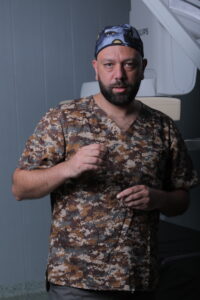
Interventional radiologists Mohammed Almoaiqel (King Abdulaziz Medical City, Riyadh, Saudi Arabia), Karim Abd El Tawab (Ain Shams University Hospitals, Cairo, Egypt) and Mohammad Al-Twalah (Dawali Clinic, Riyadh, Saudi Arabia) speak to Interventional News about the pros and cons of private practice in the Middle East and North Africa (MENA) region, surveying the spectrum of opportunities and challenges faced by interventionists today.
The significant traction of interventional radiology (IR) as a specialised field has been marked on a global scale in recent years. For interventionists in the MENA region, demand for IR’s minimally invasive procedures has steadily increased year on year with growing awareness of its benefits for a range of indications. Although public healthcare systems in the MENA region have traditionally been the primary providers of interventional treatments, a tangible uptick in private healthcare institutions—or office-based labs (OBLs)—has been observed.
In Almoaiqel’s view, private practice runs alongside his role at the government hospital in Riyadh, which means that from 8am–5pm he can be found at the hospital, and from 5–9pm he covers a private IR clinic. In his OBL setting, he is able to perform “pure, elective IR procedures” such as embolization— including prostate artery embolization (PAE) and uterine artery embolization (UAE)—as well as vascular procedures via their diabetic foot service. He stated that around 30–40% of interventional radiologists in his region also work in both settings.
“It gives us freedom—freedom to see more patients and practice IR,” Almoaiqel said, commenting on the clinical autonomy that private practice has afforded him. In many countries worldwide, IR’s distinction from diagnostic radiology (DR) or radiology is still being forged, which equally applies to the MENA region. As Abd El Tawab added, most interventionists that open OBLs still perform DR procedures alongside IR, and the number of “true IR” clinics are still few.
The prevalence of these catch-all clinics, Abd El Tawab pointed out, may be in part due to the competitive nature of private practice IR in Egypt, where he practises. “No one will refer to us—no urologist, gynaecologist, or surgeon will send patients to us. All patients are self-referred, so we have to recruit them,” he stated.

Due to the increasingly saturated market, establishing a reputable presence to recruit patients has equated to marketing initiatives, with OBLs differentiating their services via social media advertisements. In Egypt, medical advertising is legal, which means Abd El Tawab’s private practice runs Facebook ads to reach patients—“they see the ads, they come, and they are convinced”, he said.
To Al-Twalah, the age of social media advertising in private practice IR has been “very challenging”, particularly in Riyadh. “People have moved online, they’re watching videos on TikTok and Instagram and you have to be there to be seen—it’s not us, but we have a team for that. We have daily challenges with this.”
Viewing social media as a double-edged sword, Almoaiqel attested to the benefit of educational campaigns which have been furthering the reach of IR, and what their procedures can do. Erecting a booth near their private clinic, his team have distributed brochures in the past, in order to spread awareness of IR treatments in their community.
“It’s a slow process,” Almoaiqel said, “but our community awareness must be improved—many women are not aware of fibroid embolization as a non-surgical alternative option, and our rate of amputation for diabetic foot is very high. We could save those feet and limbs by doing endovascular procedures.”
However, caseloads in public hospitals remain high, all three speakers asserted. Despite the lack of visibility of IR procedures, interventionists are experiencing long wait times and convoluted patient access. For this reason, Almoaiqel detailed his governments initiative to “relieve pressure” on public hospitals and insurance companies. He said that they have “facilitated investment” into private practice, “simplifying the opening of new facilities”. This support for OBLs also relieves pressure on the government to pay for the health sector, he continued.
Yet, as the government “injects support” into private practice, Almoaiqel said, challenges arise as “most patients are not insured, and they have to pay from their own pocket—this is a limitation”. He added that IR procedures are not cheap, some even working out to be more expensive than surgical procedures, via the specialist materials and technology that are required. “This limits us to patients who are able to pay,” he said. Abd El Tawab added that, in Egypt, patients’ insurance often “covers everything or nothing”, highlighting a discrepancy between funding and insurance coverage, which may be blocking patient access to private IR treatment.

Historically, private practice has provided interventional radiologists with a higher earning potential compared to that of public hospitals. Yet, in Al-Twalah’s experience, the value in switching to private practice came from being “able to do what you want to do”. “Life is short—your work has to be enjoyable for both you and the patient, and in a good setting with a focused team.” Often private practices have a condensed, multidisciplinary team working under “one umbrella”, which Almoaiqel believes is the key to “long-term success” in private practice.
“In our clinic we have phlebologists, interventional radiologists, vascular surgeons and a podiatrist. In supporting each other to forward this vision for IR, the continuity of care we can achieve for patients is limitless,” Almoaiqel said.













